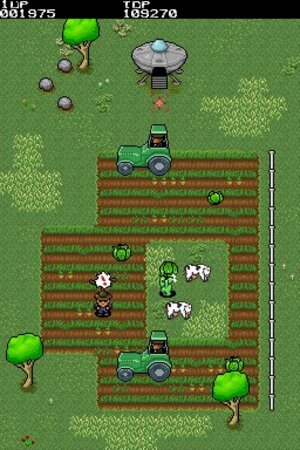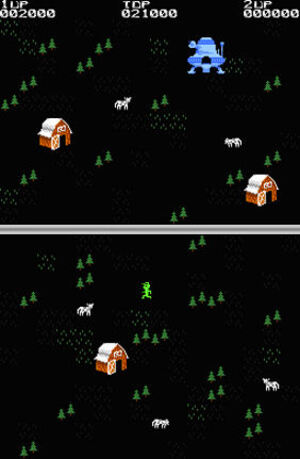
With the recent announcement of Alien Havoc coming to the DSiWare service, we wanted to get in touch with its creators to find out a little bit more about the game and what we can expect from this release.
Thankfully the good people at Creat Studios were kind enough to take time out of their busy schedule to take part in an exclusive interview with Nintendo Life. Proving that three is not a crowd, Scott Hyman (director of business development), John Manuelian (producer and game programmer) and Ben Rodgers (artist) were very open about what we could expect from this intriguing title.
Nintendo Life: To kick things off can you tell us a little bit about Creat Studios?
Scott: Creat is a developer and downloadable publisher with offices in Boston, Massachusetts and St. Petersburg, Russia. We’ve been around for a while, creating games for all platforms. Our most recent releases were Magic Ball and Cuboid for PlayStation Network, and Tony Hawk’s Motion for the Nintendo DS.

Nlife: What made the DSiWare platform such an attractive option to develop a game for?
John: I grew up in the NES/SNES generation, and to me, 2D DS games are an extension of that time period. When I heard that DSi would support a downloadable games service, I was immediately excited about the possibilities that service could offer.
Ben: We also had prior experience on the Nintendo DS platform, so the move to DSi was seamless.
Nlife: How did the idea for Alien Havoc first come about?
John: As a retro gamer in a modern developer world, I’m torn between two sides of the spectrum: The “golden age” of gaming vs. the modern expectations of games. To appease both sides, I decided to create a new game with the classic feel but a modern skin. I initially designed Alien Havoc around the technology and mind frame of a 80s programmer. There were lots of space games in 1982, so a space themed game seemed appropriate, but I didn’t want to make just another Space Invaders/Galaga clone. I took some inspiration from games such as Venture, Leprechaun, and Tazz Mania when designing the gameplay. I forced myself to keep this game as close to those 8-bit games as I could for as long as I could. To ensure the game had this very particular feel to it, I decided to write the initial game concept in ASM for a machine that was very popular in the 1980s. Only after I was happy with that game did I start making a prototype on DS hardware, still using the old 8-bit graphics. I really wanted to retain as much of the classic arcade feel that I could on modern consoles.

Ben: When John showed me an early prototype, I was immediately hooked on the premise and style of the game. It’s simple mechanics make it easy to grasp and dive right in. When I heard that it was going to be reworked for the DSi, I jumped at the chance to be a part of it.
Nlife: How long has the game been in development for?
John: From concept to completion, about 9 months, but due to work on other projects, we often had to start and stop work on Alien Havoc. 2 months for the concept game, about 3 months for the DS prototype, and about 5 months for the final product.
Nlife: What is the basic premise behind the game?
John: The classic tale of aliens pestering humans, or humans pestering aliens (depending on your point of view).
Ben: There was also some Sci-fi B-movie influence.
Nlife: What makes the game so challenging to play and what tactics can a player use to steal the livestock?

Ben: There is a mix of puzzle, maze, action, and stealth elements in the game.
John: This game uses both screens as one big wrapping playfield. You go off the left side, you appear on the right. Because of that, there will be some levels that are very maze-like and, the first couple times through, will be quite confusing. Other levels require precise timing to sneak up to a cow and snatch it from a farmer. Of course, the player could always just grab things and try to Rambo through a level. It won’t always work though.
Nlife: What inspired the retro graphical style? Is it more 8-bit or 16-bit?
John: 8-bit graphics are not really acceptable anymore, except in very rare situations. To keep up a bit with the higher expectations people have these days, we moved towards what could be considered 16-bit art. I gave Ben some specific pixel art reference for the game’s artwork because I think hand pixel art looks much nicer than 3d rendered sprites for games like this - it adds more personality to the game.

Ben: After reviewing the reference I had a clear direction about the specific style were looking to produce. The Menus and Title screens allowed me to put some personality into the characters and tell a story.
Nlife: What can we expect from the control scheme? How will the stylus be implemented?
John: The controls only use the D-pad and buttons. I would have liked to add optional stylus controls, but I couldn’t because the gameplay is on both screens.
Nlife: How long do you think it will take for an average gamer to complete Alien Havoc? Will there be extra modes to go back to when the main game is completed?
Ben: For the main game (Cow Caper), about an hour, if you know what you’re doing. The mini game (Bovine Blitz) could potentially last forever if you’re good.
John: There are extra things that can be unlocked. There is a mini game that will unlock when the main game is completed, and there are some additional alien heads that can be unlocked as well.

Nlife: When do you plan to release the game in North America and how much will it cost?
Scott: Exact release dates and pricing are being determined now. But we expect to release by the end of the summer.
Nlife: Are you planning a European release at this stage?
John: Yes - USA, Europe, and Japan.
Scott: Creat is a worldwide publisher, and we look forward to bringing Alien Havoc to every corner of the globe that we can.
Nlife: Creat Studios is known for developing games for other publishers. What challenges did you find taking on the role of publisher for downloadable titles?
Scott: The greatest challenge is forcing limitations on ourselves. When working for other publishers, the scope of a project is determined beforehand. But, when publishing our own products, we get much more creative freedom. Our designers, engineers and artists have so many great ideas, and we have to keep everything within the limits of the project.
Nlife: Do you have any plans to develop games for WiiWare in the future?
Scott: Absolutely. Creat is dedicated to the downloadable game space, and WiiWare is a big part of that.
Nlife: Do you have anything else you'd like to tell our readers in closing?
John: I have had a lot of fun making this game. I hope people who buy it will have just as much fun playing it as well.

Comments 21
Cool interview. Looks interesting.
This game looks really cool. Hope its out soon.
Wow Corbie. Well this interview piqued my interest, looking forward to this one.
I have to say this looks awesome. Another to add to the watch-list. Score-based tends to mean loads of replay value...
Very nice Corbie. Oh and FIFTH FIFTH FIFTH FIFTH FIFTH FIFTH YAY WOW FIFTH OH MY!!!!!
Good interview, game doesn't sound so great though. The games they took inspiration from weren't all that great.
Ahem... Oh and SEVENTH SEVENTH SEVENTH SEVENTH SEVENTH SEVENTH YAY WOW SEVENTH OH MY!!!!! I'm done. Anyway, game has potential to be the next great DSiWare release.
SWEET... I want to steal some cows. Ive been cow tippin in real life before and thats really fun but this looks pretty cool too. Nice to see that developers are really signing on to DSiWare.
Magic Ball and Cuboid are both good games, so I assume this will be the same.
Looks like a nice little throwback to old arcade games. I'll keep my eye on it.
Oh, and TENTH.
I'll buy this for two reasons;
1. They appear to care about all regions and not just the US, cough*High Voltage Software*cough.
2. The guy could have flat out lied and said the game is 5 to 10 hours long or something. He took a risk and was honest about it's length. I can respect, and appreciate that.
@Chicken Brutus: That's funny, I tend to think that score-based gameplay means little-to-no replay, or even play for that matter, value. That said, this COULD be interesting, if the actual gameplay itself is good.
@Gavin Rozee: Oh, is The Conduit not heading to Europe or something? I must've missed that news...sorry about that (seriously, I sympathize, because that just sucks)! I do agree that respect is due a man who isn't afraid to admit his game is SHORT! Note that he did say "if you know what you're doing," though. Expect the first playthrough to be a bit longer than that.
Interesting, but I don't think its for me...
@Stuffgamer:
To each his own, I guess. But usually story-based stuff (like Legend of Zelda) needs time to "digest" (so to speak) before I pick it up again. I can't play through those games twice in a row...I'll need to beat them, move on, and come back to them a year later, if ever.
Score based games are just that...score-based. You can pick it up again immediately just to try to beat your old score. It's also, usually, something you can play for a few minutes here and there without having to immerse yourself in it.
Besides, are you telling me Pacman, Tetris and Dr. Mario don't have loads of replay value?
Good Intervieuw, Though The Game Might Suck...
@Chicken Brutus: I guess I'm just not the kind of guy who generally wants to replay a limited game just to increase my score. I want more from a game than that, generally. I play Pacman and Tetris only occasionally, and in relatively short bursts, because that's all they're worth to me. Not a Dr. Mario fan in general.
I didn't mean to suggest I'd replay a story based game IMMEDIATELY after beating it, but that it has more value to play again because it actually has compelling components to it.
Oh no, I understood you Stuffy. I'm just giving you a hard time.
As I say, I understand that different people have different tastes. Personally, I cannot FATHOM someone who isn't addicted to Tetris...but at the same time, I'm sure you're questioning my mental health in return.
So...it all balances out.
Looks like a fun little title. This will certainly be one to look forward to.
I really dig the art style. Wouldn't mind payin 500 or 800 for this
I would only pay 200-500 for this. It looks cool, but if it lasts only an hour then it's not worth the full 800
looking forward to this, but i may need a review.
Show Comments
Leave A Comment
Hold on there, you need to login to post a comment...